Your cart is currently empty!
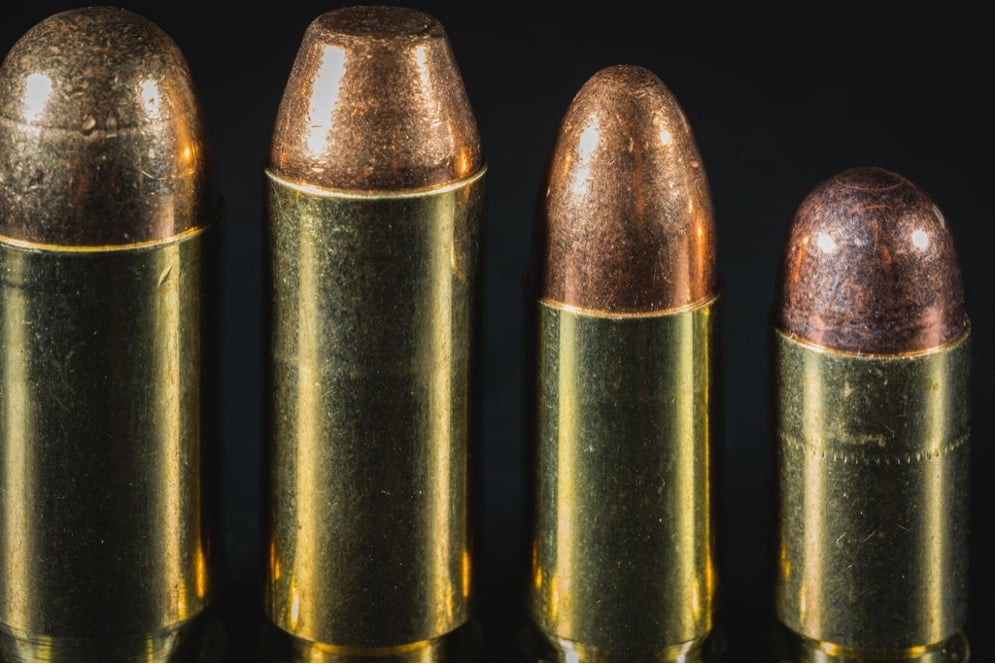
.380 vs .45 ACP: A Complete Caliber Comparison
Table of Contents:
The Short Answer: The .45 ACP offers superior stopping power and wound potential but requires a larger handgun, while the .380 ACP provides easier concealment and lower recoil in compact firearms. Your choice should depend on your specific shooting needs and handling preferences.
When it comes to handgun calibers, the .380 ACP and .45 ACP each offer unique advantages, shaped by their distinct histories and purposes. These two cartridges represent different eras and philosophies in firearms development. The .45 ACP, introduced in 1904 by John Moses Browning, emerged from military needs for a powerful service pistol cartridge. The .380 ACP, also designed by Browning, came later as an answer to the growing demand for compact defensive firearms.
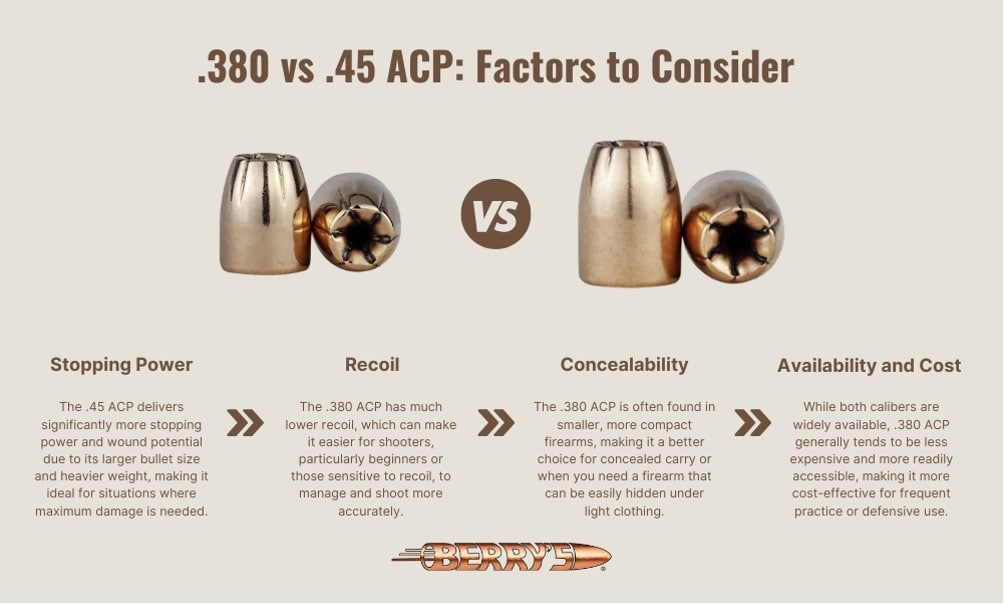
Physical Characteristics and Specifications
Size Comparison
The .380 ACP and .45 ACP cartridges represent significantly different approaches to handgun caliber design. The .380 ACP features a bullet diameter of .355 inches, while the .45 ACP measures .451 inches – demonstrating the larger caliber’s substantial difference of nearly one-tenth of an inch. The .380’s case length is 17mm, making it notably shorter than the .45 ACP’s 22.8mm case length. When comparing overall length, the .380 ACP measures 25mm total, versus the .45 ACP at 32mm.
Technical Details
Standard bullet weights for the .380 ACP ammo typically range from 90 to 100 grains. The .45 ACP operates with much heavier projectiles, commonly between 185 and 230 grains, with 230 grains being the traditional standard weight.
Muzzle velocity profiles differ markedly between these cartridges. The .380 ACP generates velocities between 880 to 1,000 feet per second with standard loads. The .45 ACP, despite its larger diameter bullet, typically operates at similar or slightly lower velocities, ranging from 850 to 950 feet per second with standard-weight bullets.
Pressure ratings highlight another significant difference. The .380 ACP operates at a maximum pressure of 21,500 PSI, while the .45 ACP runs at 21,000 PSI – remarkably similar despite their size difference. When comparing muzzle energy, the .380 ACP typically delivers 190 to 220 foot-pounds at the muzzle. The .45 ACP, with its heavier bullets, produces substantially more energy – typically 350 to 400 foot-pounds, making it a more powerful round overall.
.380 ACP Analysis
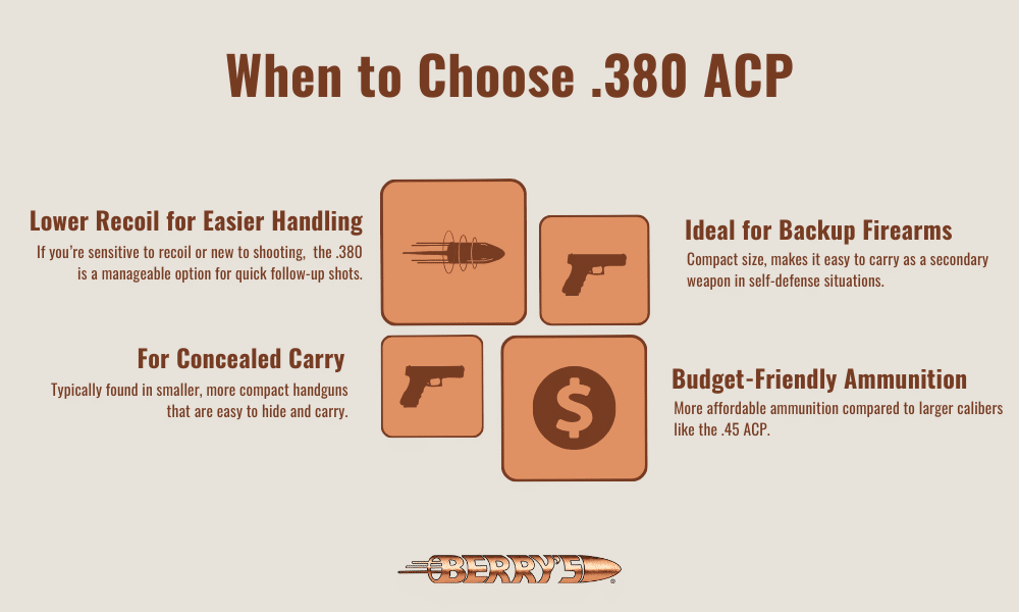
Advantages
- Portability: Modern .380 ACP semi-automatic pistols are highly compact, making them ideal for concealed carry. Many models are thin enough to disappear under light clothing.
- Reduced Recoil: Produces less recoil compared to larger calibers, making it manageable for recoil-sensitive shooters and those wanting faster follow-up shots.
- Concealability: Smaller frame sizes make .380 ACP firearms well-suited for various carry positions and clothing choices. Guns like the Ruger LCP and Walther PPK are great for backup or deep concealment.
- Cost: .380 ACP ammunition is widely available and typically affordable, though prices may vary based on market conditions and location.
Limitations
- Terminal Performance: The .380 ACP struggles with achieving both adequate penetration depth and bullet expansion, often excelling in one but not the other. Larger calibers tend to outperform it in this regard.
- Muzzle Velocity: The .380 ACP loses accuracy and muzzle energy more quickly over longer distances, making it less effective at range compared to larger calibers.
- Magazine Capacity: Many .380 ACP firearms sacrifice round count for compactness. However, newer models are addressing this with extended magazines and optimized frame designs.
- Ammunition Selection: Shooters must carefully select ammunition based on specific needs, whether prioritizing shot placement through barriers or expanded diameter for energy transfer, as the ballistic performance of .380 ACP requires more precision in ammo choice.
.45 ACP Analysis
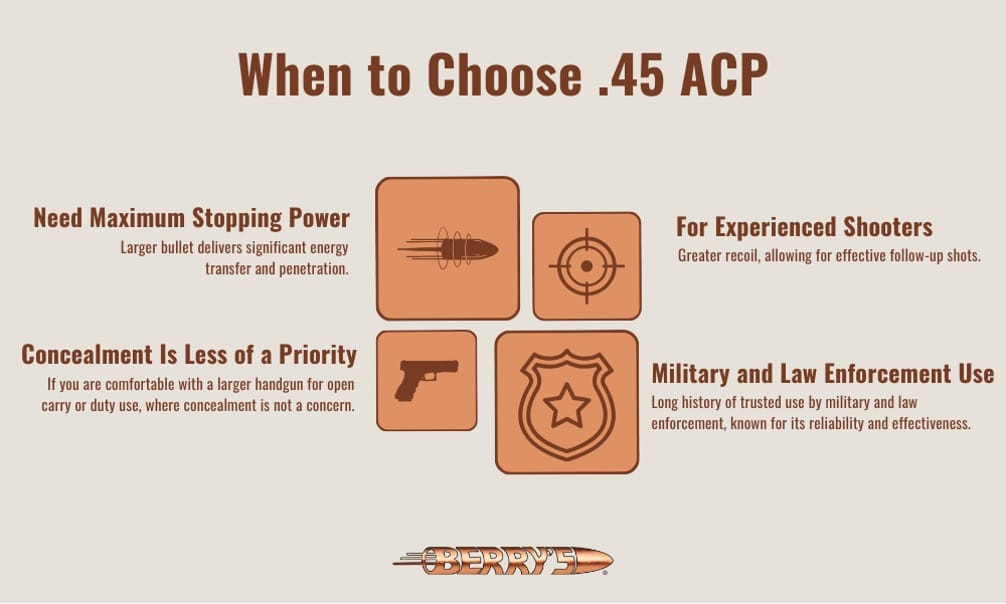
The .45 ACP cartridge stands as a landmark in firearms history, offering distinct advantages and trade-offs that shape its role in personal protection and self-defense.
Advantages
- Stopping Power: The .45 ACP is known for its significant stopping power, creating a large wound channel that maximizes energy transfer and penetration depth in soft tissue. This makes it a trusted choice for law enforcement and the military.
- Accuracy: Operates at relatively low pressures (around 21,000 PSI), leading to less recoil than expected for such a large caliber. This allows for quicker follow-up shots in experienced hands.
- Reduced Muzzle Flash & Noise: The .45 ACP’s muzzle velocity results in less muzzle flash and reduced noise compared to higher velocity rounds.
- Proven Track Record: With a history spanning over a century, the .45 ACP has been tested and trusted through both World Wars and numerous conflicts, contributing to its reliable performance.
- Refined Performance: Over the years, advancements in bullet expansion and loading techniques have led to consistently reliable test results and improved overall performance.
Limitations
- Physical Dimensions: The .45 ACP’s large bullet diameter results in wider grips and larger overall pistol dimensions, making concealment more difficult. This may not be ideal for shooters with smaller hands.
- Magazine Capacity: The cartridge’s diameter limits the number of rounds in a standard magazine, typically 7-8 rounds in single-stack configurations, compared to higher capacities in smaller calibers.
- Ammunition Weight: Loaded .45 ACP magazines are heavier than those with smaller cartridges, affecting overall ammunition weight.
- Training: While the lower pressure helps manage recoil, the larger bullet mass still produces substantial felt recoil, requiring dedicated training to master.
- Higher Ammo Costs: .45 ACP ammunition tends to be more expensive than smaller calibers, which may limit practice sessions for budget-conscious shooters.
Choosing between .380 and .45
When comparing the .380 ACP and .45 ACP cartridges, each caliber brings distinct advantages to the table. The .380 ACP offers less recoil and pocket pistol options, making it suitable for personal protection and shooters who value small size. The .45 ACP delivers superior stopping power and proven bullet expansion, particularly appealing to those who prioritize larger wound channels and don’t mind the added weight.
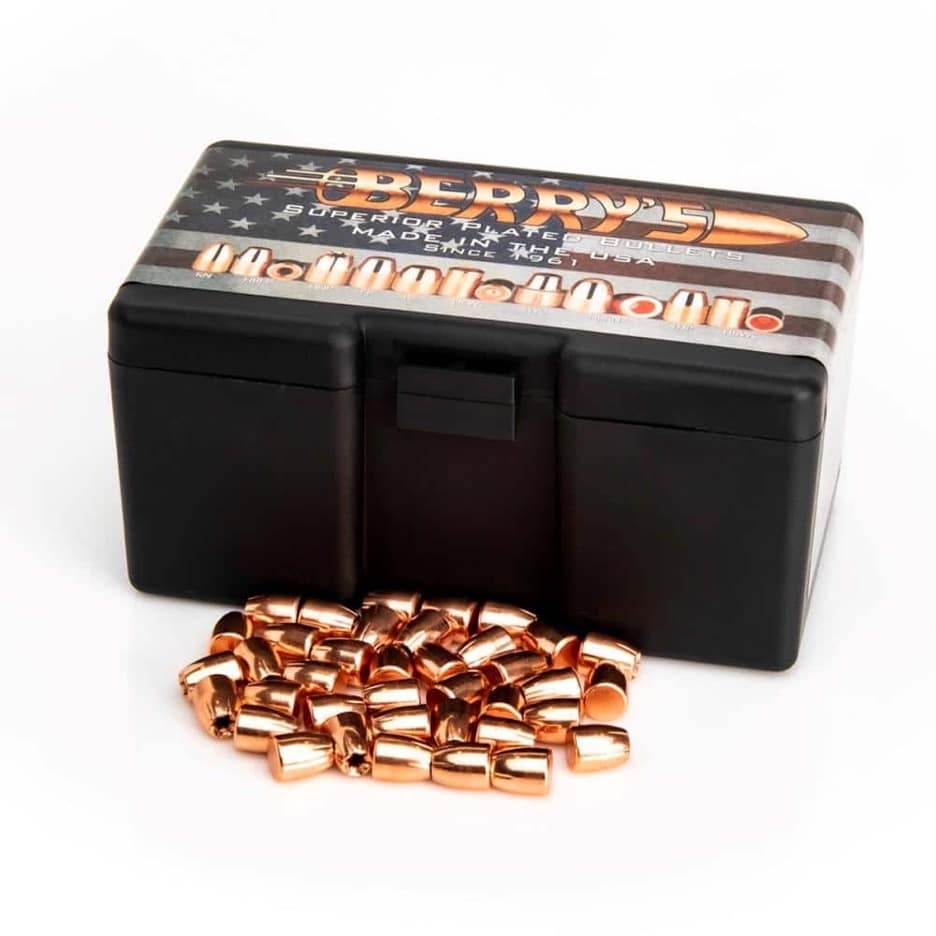
For shooters who demand top-tier performance, Berry’s Manufacturing delivers precision-engineered bullets that stand up to the toughest standards. Crafted in the USA with exceptional quality, our bullets are built for accuracy and reliability—whether you’re in law enforcement or a civilian shooter. Trust Berry’s for premium bullets that enhance your shooting experience and deliver results when it matters most.
Ready to experience the difference quality bullets make in your shooting? Visit Berry’s Manufacturing for our complete selection of .380 and .45 caliber bullets.
